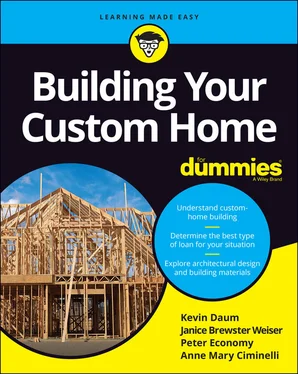Planning department: Your house needs to meet your neighborhood’s zoning requirements before you get permits. This department enforces the zoning (see Chapter 6).
Design review committee: You can’t always build what you want. This committee dictates what it wants to see in your design (see Chapter 6).
Building department: Everything must meet code, and this department checks your plans before issuing permits (see Chapter 6).
Appraiser: The lender won’t approve a construction loan without an appraisal estimating the finished value (see Chapter 10).
Insurance agent: Chapter 2spells out all the insurance you need for the project. This person provides the goods — they’ll be busy.
Material suppliers: Sticks and stones all have to come from somewhere. Some projects have many sources (see Chapter 7).
Subcontractors: Each one is an expert … just ask them. Artisans and craftspeople build each different system in your house. Chapter 7tells you how to work with them. Chapters 12, 13, and 14explain what they do.
Laborers: Somebody has to do the grunt work on the job. These people work the hardest and get paid the least.
Building inspectors: The building department checks up at various stages of construction to see that you’re building in line with regulations (see Chapter 7).
Disbursement agents: The lender assigns someone to make sure you get money when you need it or to solve problems with getting money from the lender. (You can find more on these agents in Chapter 11.)
Bank inspectors: The bank won’t give you money unless work has been done. These people come out to the property monthly or at various stages to make sure the work is complete (see Chapter 7).
Landscaper: Usually the last part to go in, but sometimes the landscaper designs the landscaping at the beginning. This person makes the yard green with your green. (Check out Chapter 16for more info.)
Mover: After all this work and trouble, the last thing you want to do is make 20 trips with the minivan. Let the movers do the work for you. (Turn to Chapter 15for specifics.)
Decorator: If you have any money left at the end, you’ll have plenty of furnishings to spend it on. An interior decorator can help.
Although your architect or contractor may manage some of these relationships, ultimately you’ll need to coordinate all these people in order to complete the project. You’ll meet many new people in this process, so put on your best smile and get ready to shake a lot of hands.
So many tasks, so little time: Fifty steps to a custom home
You’re probably wondering why the custom-home process has so many people involved. The simple answer: The custom-home process has tons of tasks that need to be done. Although each home-building process may have some variation in the stages based upon factors such as location and weather, for the most part, the process moves in a step-by-step fashion.
The following list shows how a typical custom-home process moves forward. The chapter references direct you to detailed discussions later in the book.
1 Decide you’re ready to tackle the custom-home process (see Chapter 2 ).
2 Meet with financial experts, including loan officers, and get organized (see Chapter 2 ).
3 Prepare cash flow with financing on your existing house (see Chapter 2 ).
4 Find land and make an offer (see Chapter 3 ).
5 Obtain land financing (see Chapter 3 ).
6 Close escrow on the lot (see Chapter 3 ).
7 Get surveys and soil reports (see Chapter 3 ).
8 Get well and septic approvals, if required (see Chapter 6 ).
9 Interview and pick an architect, if applicable (see Chapter 5 ).
10 Create the house’s preliminary design (see Chapter 5 ).
11 Get zoning and design review approval (see Chapter 6 ).
12 Pick all your fixtures and materials (see Chapter 5 ).
13 Submit the plans for building approval (see Chapter 6 ).
14 Make the required plan changes (see Chapter 5 ).
15 Put the plans out to bid with contractors (see Chapter 2 ).
16 Interview and choose a contractor (see Chapters 2 and 7 ).
17 Apply for a construction loan (see Chapters 9 and 10 ).
18 Get an appraisal based on future value (see Chapter 10 ).
19 Get final approval for permits and pay fees (see Chapter 6 ).
20 Close escrow on the construction loan (see Chapter 9 ).
21 Set up a disbursement account (see Chapter 11 ).
22 Set up communications with the contractor and subs (see Chapter 7 ).
23 Prepare the building site for work (see Chapter 12 ).
24 Grade and/or excavate the property (see Chapter 12 ).
25 Trench for foundation, water, and sewer (see Chapter 12 ).
26 Pour the concrete for foundation and let cure (see Chapter 12 ).
27 Frame the exterior (see Chapter 13 ).
28 Frame the interior (see Chapter 13 ).
29 Install the windows (see Chapter 13 ).
30 Install the fireplaces (see Chapter 13 ).
31 Install the rough heating, ventilation, and air conditioning (HVAC) (see Chapter 13 ).
32 Install the rough plumbing (see Chapter 13 ).
33 Install the rough electrical (see Chapter 13 ).
34 Install the roof (see Chapter 13 ).
35 Install the outer sheathing (see Chapter 13 ).
36 Apply the exterior siding or stucco and paint (see Chapter 14 ).
37 Install the drywall (see Chapter 14 ).
38 Install the cabinetry and millwork (see Chapter 14 ).
39 Install tile, counters, moldings, and finish carpentry (see Chapter 14 ).
40 Install the doors (see Chapter 14 ).
41 Paint the interior and finish woodwork (see Chapter 14 ).
42 Install the plumbing fixtures (see Chapter 14 ).
43 Install the electrical fixtures and hardware (see Chapter 14 ).
44 Install the flooring (see Chapter 14 ).
45 Request the final loan disbursement (see Chapter 15 ).
46 Request final inspection and receive a certificate of occupancy (see Chapter 15 ).
47 Roll to permanent financing (see Chapter 17 ).
48 Install the landscaping, including the deck, pool, spa, and so on (see Chapter 16 ).
49 Sell your old house (see Chapter 17 ).
Читать дальше












